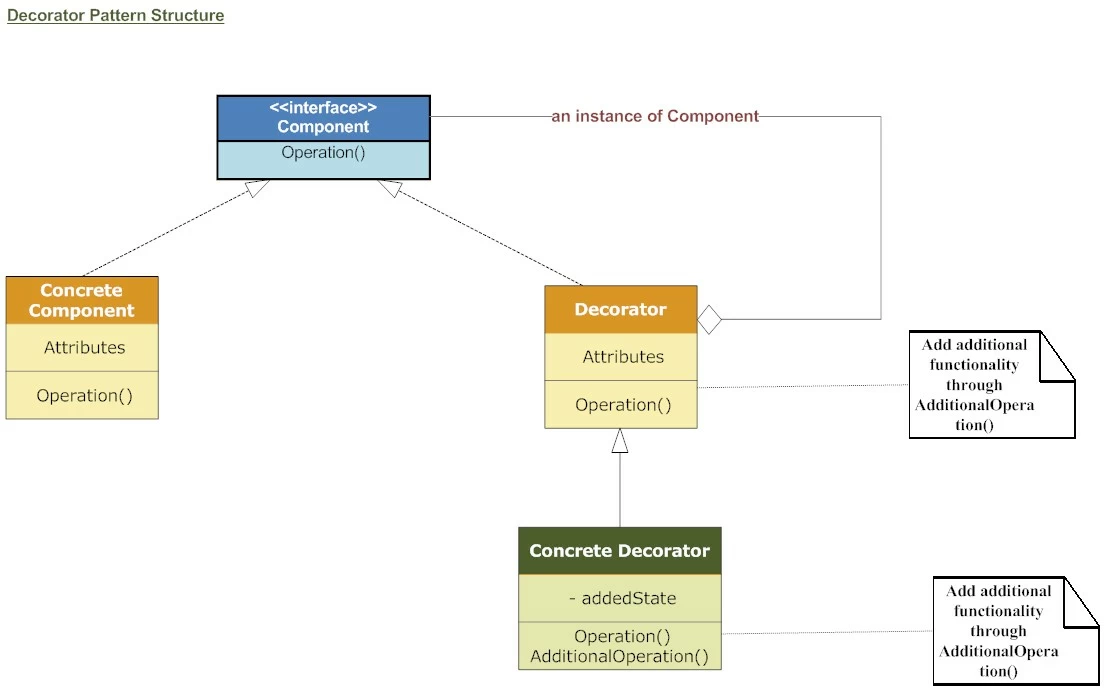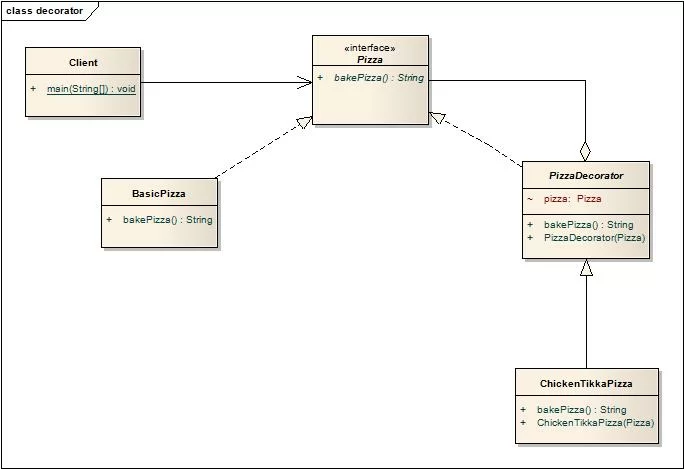Decorate with decorator design pattern
 Decorator pattern is one of the widely used structural patterns. This pattern dynamically changes the functionality of an object at runtime without impacting the existing functionality of the objects. In short this pattern adds additional functionalities to the object by wrapping it.
Decorator pattern is one of the widely used structural patterns. This pattern dynamically changes the functionality of an object at runtime without impacting the existing functionality of the objects. In short this pattern adds additional functionalities to the object by wrapping it.
Problem statement:
Imagine a scenario where we have a pizza which is already baked with tomato and cheese. After that you just recall that you need to put some additional topping at customer’s choice. So you will need to give some additional toppings like chicken and pepper on the go.
Intent:
Add or remove additional functionalities or responsibilities from the object dynamically without impacting the original object.
At times it is required when addition of functionalities is not possible by subclassing as it might create loads of subclasses.
Solution:
So in this case we are not using inheritance to add additional functionalities to the object i.e. pizza, instead we are using composition. This pattern is useful when we don’t want to use inheritance and rather use composition.
Structure

Following are the participants of the Decorator Design pattern:
- Component – this is the wrapper which can have additional responsibilities associated with it at runtime.
- Concrete component– is the original object to which the additional functionalities are added.
- Decorator-this is an abstract class which contains a reference to the component object and also implements the component interface.
- Concrete decorator-they extend the decorator and builds additional functionality on top of the Component class.
Example:

In the above example the Pizza class acts as the Component and BasicPizza is the concrete component which needs to be decorated. The PizzaDecorator acts as a Decorator abstract class which contains a reference to the Pizza class. The ChickenTikkaPizza is the ConcreteDecorator which builds additional functionality to the Pizza class.
Let’s summarize the steps to implement the decorator design pattern:
- Create an interface to the BasicPizza(Concrete Component) that we want to decorate.
- Create an abstract class PizzaDecorator that contains reference field of Pizza(decorated) interface.
- Note: The decorator(PizzaDecorator) must extend same decorated(Pizza) interface.
- We will need to now pass the Pizza object that you want to decorate in the constructor of decorator.
- Let us create Concrete Decorator(ChickenTikkaPizza) which should provide additional functionalities of additional topping.
- The Concrete Decorator(ChickenTikkaPizza) should extend the PizzaDecorator abstract class.
- Redirect methods of decorator (bakePizza()) to decorated class’s core implementation.
- Override methods(bakePizza()) where you need to change behavior e.g. addition of the Chicken Tikka topping.
- Let the client class create the Component type (Pizza) object by creating a Concrete Decorator(ChickenTikkaPizza) with help from Concrete Component(BasicPizza).
- To remember in short : New Component = Concrete Component + Concrete Decorator
Pizza pizza = new ChickenTikkaPizza(new BasicPizza());
Code Example:
BasicPizza.java
1 2 3 | public String bakePizza() { return 'Basic Pizza'; } |
Pizza.java
1 2 3 | public interface Pizza { public String bakePizza();} |
PizzaDecorator.java
01 02 03 04 05 06 07 08 09 10 | public abstract class PizzaDecorator implements Pizza { Pizza pizza; public PizzaDecorator(Pizza newPizza) { this.pizza = newPizza; } @Override public String bakePizza() { return pizza.bakePizza(); }} |
ChickenTikkaPizza.java
1 2 3 4 5 6 7 8 | public class ChickenTikkaPizza extends PizzaDecorator { public ChickenTikkaPizza(Pizza newPizza) { super(newPizza); } public String bakePizza() { return pizza.bakePizza() + ' with Chicken topping added'; }} |
Client.java
1 2 3 4 5 | public static void main(String[] args) { Pizza pizza = new ChickenTikkaPizza(new BasicPizza()); System.out.println(pizza.bakePizza()); } |
Benefits:
Decorator design pattern provide more flexibility than the standard inheritance. Inheritance also extends the parent class responsibility but in a static manner. However decorator allows doing this in dynamic fashion.
Drawback:
Code debugging might be difficult since this pattern adds functionality at runtime.
Interesting points:
- Adapter pattern plugs different interfaces together whereas decorator pattern enhances the functionality of the object.
- Unlike Decorator Pattern the Strategy pattern changes the original object without wrapping it.
- While Proxy pattern controls access to the object the decorator pattern enhances the functionality of the object.
- Both Composite and Decorator pattern uses the same tree structure but there are subtle differences between both of them. We can use composite pattern when we need to keep the group of objects having similar behavior inside another object. However decorator pattern is used when we need to modify the functionality of the object at runtime.
- There are various live examples of decorator pattern in Java API.
- java.io.BufferedReader;
- java.io.FileReader;
- java.io.Reader;
If we see the constructor of the BufferedReader then we can see that the BufferedReader wraps the Reader class by adding more features e.g. readLine() which is not present in the reader class.
We can use the same format like the above example on how the client uses the decorator pattern new BufferedReader(new FileReader(new File(“File1.txt”)));
Similarly the BufferedInputStream is a decorator for the decorated object FileInputStream.
BufferedInputStream bs = new BufferedInputStream(new FileInputStream(new File(“File1.txt”)));
Reference: Gang of Four – Decorate with decorator design pattern from our JCG partner Mainak Goswami at the Idiotechie blog.



A fancy word for DPI…. lmao.
Would it get worse if the below was used:
PizzaDecorator.java: public abstract String bakePizza();